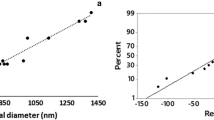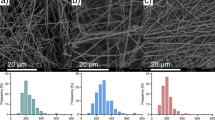Abstract
Titanium dioxide and magnetic cobalt based materials are one of the most attractive materials for investigation due to their dramatic photocatalytic, optical, biomedical, magnetic and electrical applications. However, there is limited or no information about the possible impact of cobalt based titanium dioxide (Co-doped TiO2) nanofibers on muscle cells. This study focuses on the interaction of magnetic cobalt based titanium dioxide nanofibers with C2C12 cell line. C2C12 mouse myoblasts were used to evaluate the beneficial/or toxicological effects of Co-doped TiO2 on cells. The effects of Co-doped TiO2 nanofibers on the morphology, cytotoxicity and adhesion ability of C2C12 cells, as well as on the cell death were evaluated. To examine the in vitro cytotoxicity, mouse myoblast C2C12 cells were treated with different concentrations of synthesized Co-doped TiO2 nanofibers and the viability of cells was analyzed by cell counting Kit-8 assay at regular time intervals. The morphological features of the cells were examined by microscopy and cell attachment with nanofibers was observed by scanning electron microscopy respectively. Experiments indicate that the mouse myoblast cells could attach to the nanofibers after being cultured. Cell viability was determined as a function of incubation time; with increasing concentration of Co-doped TiO2, the cell viability decreased. Thus from the obtained results it was concluded that Co-doped TiO2 nanofibers could support cell adhesion and growth of myoblast cells, however the cell compatibility decreases with high doses and after sustained exposure.




Similar content being viewed by others
References
Mieszawska AJ, Kaplan DL (2010) BMC Biol 8:59
Ma PX (2008) Adv Drug Deliv Rev 60:184
Shin H, Jo S, Mikos AG (2003) Biomaterials 24:4353
Lan MA, Gersbach CA, Michael KE, Keselowsky BG, Garcia AJ (2005) Biomaterials 26:4523
Choi JS, Lee SJ, Christ GJ, Atala A, Yoo JJ (2008) Biomaterials 29:2899
Baker SC, Southgate J (2008) Biomaterials 29:3357
Lutolf MP, Hubbell JA (2005) Nat Biotechnol 23:47
Huber A, Pickett A, Shakesheff KM (2007) Eur Cell Mater 14:56
Dugan JM, Gough JE, Eichhorn SJ (2010) Biomacromolecules 11:2498
Huang NF, Patel S, Thakar RG, Wu J, Hsiao BS, Chu B, Lee RJ, Li S (2006) Nano Lett 6:537
Niinomi M, Nakai M (2011) Int J Biomater 2011:836587
Jokinen M, Pa¨tsi M, Rahiala H, Peltola T, Ritala M, Rosenholm JB (1998) J Biomed Mater Res 42:295
Nygren H, Eriksson C, Lausmaa J (1997) J Lab Clin Med 129:35
Nygren H, Tengvall P, Lundstrom I (1997) J Biomed Mater Res 34:487
Wintermantel E, Mayer J, Ruffieux K, Bruinink A, Eckert KL (1999) Chirurg 70:847
Wintermantel E, Cima L, Schloo B, Langer R (1992) Angiopolarity of cell carriers, directional angiogenesis in resorbable liver cell transplantation devices. In: Steiner R, Weisz B, Langer R (eds) Angiogenesis: principles science-technology-medicine. Birkhaeuser Verlag, Basel
Liu X, Chu PK, Ding C (2004) Mater Sci Eng R 47:49
Wang RM, Liu CM, Zhang HZ, Chen CP, Guo L, Xu HB, Yang SH (2004) Appl Phys Lett 85:2080
Li T, Yang SG, Huang LS, Gu BX, Du YW (2004) Nanotechnology 15:1479
Yoon YI, Moon HS, Lyoo WS, Lee TS, Park WH (2009) Carbohydr Polym 5:246
Karlsson HL, Gustafsson J, Cronholm P, Moller L (2009) Toxicol Lett 188:112
Eun HK, Yoon YJ, Park JH, Yang SH, Hong D, Lee KB, Shon HK, Lee TG, Choi IS (2013) Angew Chem Int Ed 52:1
Groenke N, Seisenbaeva GA, Kaminskyy V, Zhivotovsky B, Kost B, Kessler VG (2012) R Soc Chem RSC Adv 2:4228
Lee IH, Yu HS, Lakhkar NJ, Kim HW, Gong MS, Knowles JC, Wall IB (2013) Mater Sci Eng C 33:2104
Acknowledgments
This work was fully supported by research funds of Chonbuk National University in 2013. This work has been partly supported by a grant from Next-Generation Bio-Green 21 Program (Project Nos. PJ008191 and PJ008196) Rural Development Administration, Republic of Korea. Dr. Touseef Amna sincerely acknowledges financial support from Research Academic Promotion Programme of Chonbuk National University.
Author information
Authors and Affiliations
Corresponding author
Rights and permissions
About this article
Cite this article
Amna, T., Hassan, M.S., Khil, MS. et al. Interaction of magnetic cobalt based titanium dioxide nanofibers with muscle cells: in vitro cytotoxicity evaluation. J Sol-Gel Sci Technol 69, 338–344 (2014). https://doi.org/10.1007/s10971-013-3222-3
Received:
Accepted:
Published:
Issue Date:
DOI: https://doi.org/10.1007/s10971-013-3222-3




